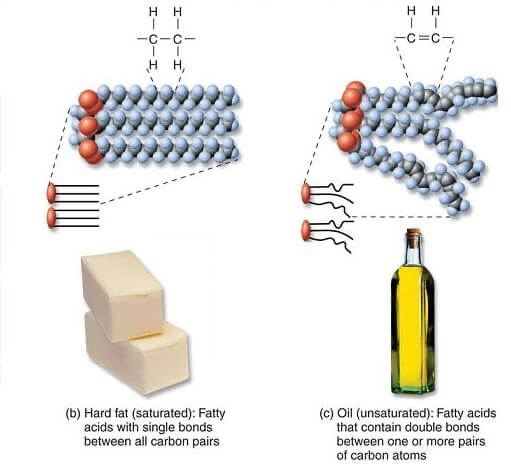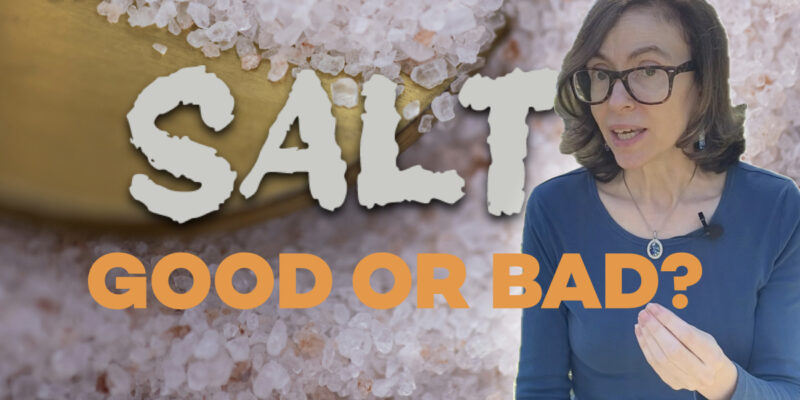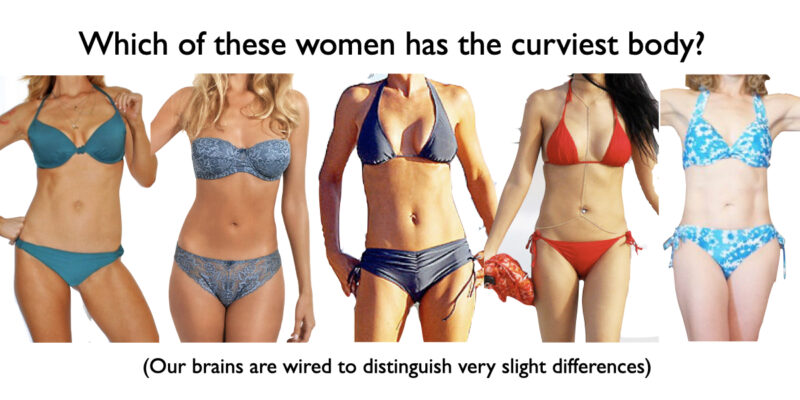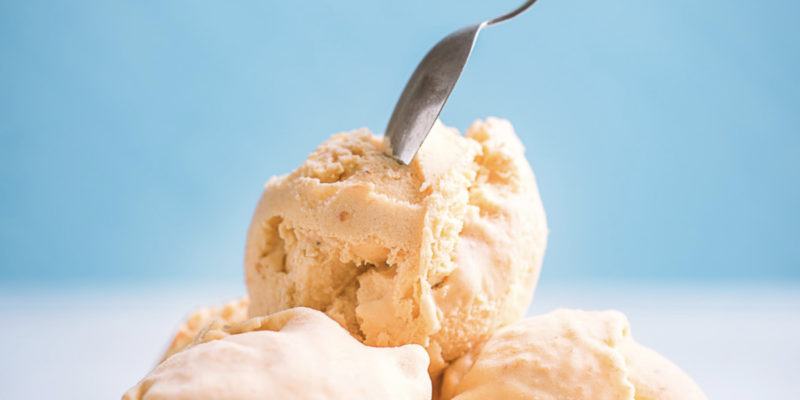You might think salt makes you bloated. It's actually something else. We hear all the…

List of Good Fats and Oils versus Bad
Table of Contents
- REFINED PUFA-Rich seed OILS a.k.a. “Vegetable oil”
- UNREFINED FATS and OILS, LOW in PUFA or high in Omega-3 and not heated
- LOOKING FOR REFERENCES? Click HERE
- TAKING FISH OIL OR OIL SUPPLEMENT?
- IT’s NOT THE OMEGA-6
- THE MYTH OF EXPELLER PRESSED
- COOKING TIPS FOR HIGH HEAT:
- SMOKE POINT
- HOW TO SUBSTITUTE VEGETABLE OIL FOR HEALTHY FATS
- HOW SEED OILS ARE MADE: Refining steps that damage PUFAs
- WHY GOOD FATS GO BAD: THE TWO CAUSES OF RANCID TASTE
- Is eating rancid food unhealthy?
- BEWARE OF “NEUTRAL” FLAVOR
- Harvard Gets It Wrong
- Common scientific terms related to fats and seed oils:
- What is artisanal oil and why is it the best?
- Can I eat seeds, nuts or fish that are high in PUFA?
- I heard peanut oil was high in PUFA, why is it listed as good?
- Sesame oil is also high in PUFA, why do you list it as good?
- Flax oil is high in PUFA, why is that good?
- Pumpkin oil, good or bad?
- What about high-oleic sunflower oil, is it better?
- What about soy or sunflower lecithin?
- What are your thoughts on Thrive Algae Oil?
- What about skin products made with seed oils?
- Palm oil is showing up in more foods. How can I tell if it’s refined?
- Is MCT oil acceptable? It is derived from coconut oil, but distilled with heat and pressure. Is it toxic?
- How long does it take to get the excessive PUFA out of my body?
- Sources:
This page is YOUR resource list of all things pertaining to edible fats and oils, please bookmark if you are interested in this topic.
Please read the FREQUENTLY ASKED QUESTION section for oils not addressed in the above graphic, and if not there either then please post a question for me in the comments section.
To discover how seed oils and other nutritional issues may have affected your health and how to recover the fastest, please schedule a consultation.
This article is continued below...(scroll down)
Bad Fats: NEVER eat these!
REFINED PUFA-Rich seed OILS a.k.a. “Vegetable oil”
Canola (also called “Rapeseed”), Corn, Cottonseed, Soy, Sunflower, Safflower, Grapeseed, Rice bran.
ALSO TOXIC: Refined Palm oil. (It’s not very high in PUFAs, but the refining is often more intense.)
PLUS: Anything that says hydrogenated because it’s going to start with refined oil and further process to create trans fats.
Vegetable oil is an industry term that sometimes includes olive oil, peanut, and coconut. However, when you see the word vegetable oil on the ingredients, it’s not going to be first press, unrefined olive, peanut, or coconut. It will be one of the cheap, refined PUFA-rich, seed oils listed above.
Good Fats: Eat THESE instead!
UNREFINED FATS and OILS, LOW in PUFA or high in Omega-3 and not heated
Avocado oil, Butter, Coconut Oil, Duck Fat, Ghee, Lard, Olive oil, Peanut oil, Tallow, Sesame oil, Flax oil, Walnut oil, Almond oil, Macadamia nut oil
Also: Anything that says cold-pressed and unrefined. It must say unrefined! If it says cold-pressed but is refined, it’s not good.
USE THESE FOR COOKING:
Almond oil, Avocado oil, Butter, Coconut, Duck Fat, Ghee, Lard, Macadamia nut oil, Peanut oil, Tallow, Sesame/Toasted Sesame oil (Sesame is better if combined with peanut or other stabler fat, details below)
DON’T COOK THESE
Flax oil, Walnut oil, Fish oil
Refined Oils: Limited Use
Refined high-PUFA seed oils are toxic. Refined high sat-fat/mufa oils are “ok but not great” because their fatty acids can handle the refining process without generating significant levels of mutated fatty acids and are therefore not going to be particularly toxic. However, the refining strips them of significant amounts of minerals and/or antioxidants so they are not as nutritious as their more expensive, higher-quality equivalents. You can think of them as the empty calories of the fat world. If you can afford to, get the better stuff. If you can’t, these are still far better than the high-PUFA oils. You’ll just need to be sure that the rest of your diet supplies plenty of antioxidants (lots of fresh greens and herbs, for example).
Knowledge Base:
Everything you need to know about dietary fats and oils, summarized in one place.
WHY REFINED VEGETABLE OILS (aka Seed Oils) ARE TOXIC
(The short version)
These oils contain a high percentage of polyunsaturated fatty acids (PUFAs). PUFAs are unstable, and break down rapidly when exposed to chemical stress. Ever heard of varnish? It’s what carpenters use to finish wood. Varnish is made from vegetable oils, including soy and linseed (which is rich in omega-3, like canola), because these oils are chiefly composed of PUFAs. PUFAs react with oxygen in the air to help polymerize the varnish into a nice hard coating that helps preserve the wood.
Varnish is good for your floors, but not so good for your brain, your arteries or mitochondria. I elaborate on that below, throughout this blog, and in Deep Nutrition chapters 7 and 8.
A little bit of PUFA is not a problem for us, we actually need some. And when we get PUFA from whole foods like sunflower, chia or flax seeds, it’s well protected by antioxidants nature builds into the seed. These protectants get stripped away during the industrial scale refining of sunflower and the other vegetable oils, and that’s just the beginning of the problems with vegetable oils.
The refining process not only strips away antioxidants, it makes PUFAs toxic by exposing them to heat, pressure, metals and bleaching agents. This chemically alters the molecules into a wide variety of potent toxins with long names like 4-hydroxynonanal and 4-hydroxyhexanol, aldehydes, and others. These molecules are toxic because they promote free-radical reactions that damage our cellular machinery including mitochondria, enzymes, hormone receptors, and DNA.
More information on the refining under “See How it’s Made,” below.
Aside from the fact that foods cooked in seed oils are full of toxic compounds, I believe years of consuming these high-PUFA seed oils changes our metabolism. Research into whether or not this is possible and the consequences led to a series of discoveries I wrote about in The FATBURN Fix.
Briefly, the metabolic changes begin with the fact that our body has no choice but to store the extra PUFA in our body fat. Over decades, the concentration of PUFA in our body fat gradually rises. Back in the early 1900s, our body fat PUFA percentage was 2-4. Today it’s 10-30%.
So what?
This makes body fat a poor fuel for our mitochondria and that profoundly disrupts every aspect of your metabolism. This explains why some people NEED sugar, physically–not just want it for its sweet taste. A seriously sugar-addicted brain directs your body to break down muscles to fuel the brain. And this is most likely the true underling cause of type 2 diabetes.
For more about how these oils affect our heart, brain, and DNA, please read Chapters 7 and 8 of the 2017 edition of Deep Nutrition: Why Your Genes Need Traditional Food). For a deeper dive into the reason these oils promote diabetes, weight gain, and most metabolic disease, see my latest book, The FATBURN Fix.
LOOKING FOR REFERENCES? Click HERE
The google document above is a short, organized list. There are hundreds more yet to be compiled into the document. If anyone wants to volunteer to help out with this project, please let me know!
TAKING FISH OIL OR OIL SUPPLEMENT?
Supplement companies love extracting oils from whole foods and encapsulating them, and then promoting them as somehow superior to the whole food. Common examples of supplement oils include:
- Fish oil
- Cod liver oil
- Oregano
- Cumin
- Hemp seed
- Flax
- Udo’s oil
- Borage oil
Should you even take fish oil supplements? https://drcate.com/should-i-take-fish-oil-supplements-benefits-and-harms/
Omega-3 supplements are not needed on a whole foods diet. Whole foods that are naturally high in omega-3 include raw or sprouted nuts and seeds, pasture-fed dairy and meats, liver (yum) and oily fish. If you are a vegan who cannot eat raw or sprouted nuts and seeds, then a flax oil supplement is a good way to go.
IT’s NOT THE OMEGA-6
Our diets do contain too much omega-6, yes. But a common misperception is that vegetable oils are toxic because they contain omega-6, and omega-6 is pro-inflammatory. There are two points about this misperception I want to bring to your attention.
- Vegetable oils are toxic because the fats they contain are oxidized. And it’s the double bonds that make PUFAs susceptible to oxidation. But omega-3 fats have more double bonds than omega-6, generally speaking, and so seeds with a high omega-3 content, like canola, actually lead to more toxic degradation products than seeds with a high omega-6, like soy (all else being equal).
- Our brains need omega-6. Our brains are made out equal parts omega-6 and omega-3, so we need both in roughly equal amounts.
The fact that we get too much omega-6 now is a result of two major consequences of industrial food making:
- Soy is the most commonly used vegetable oil in processed foods and restaurants by a factor of nearly twice over Canola, the second most common.
- The animals we eat are fed soy and corn, which contain lots of omega-6, and the feed is often supplemented with other vegetable oils such as cottonseed that are also high in omega-6. The animals do not burn these fats for energy (neither do we), so they are stored in the adipose tissue. This means, for example, bacon from industrially produced pigs contains a lot of omega-6.
How much vegetable oil is too much?
That’s a little like asking how many cigarettes should a 4 year old smoke. More than none is too much. However because these oils are now added to spice mixes that are added to many otherwise healthy foods, it has become almost impossible to avoid entirely. Other than spice mixes, products with vegetable oil are best avoided whenever possible.
FATS v OIL
Fats are solid at room temperature and oils are liquid. Saturated fats are stiff, so highly saturated fat. (Figure below)

FATTY ACIDS v FATS
Fatty acid refers to a molecule composed of a several carbons linked together, generally anywhere from 4 to 26 carbon atoms, with a special group at the end called a carboxyl. The chain of carbon atoms may be linked together with single bonds, and be saturated, or contain one double bond, and be mono unsaturated, or contain two or more double bonds, and be polyunsaturated. Our bodies cell membranes are composed of all three types of fatty acids. We cannot make certain fatty acids, those have to come from food, these we call essential fatty acids and they come in two types: omega-3 and omega-6.
Fats Most fats and oils we eat are composed of three fatty acids bound to glycerol to form a structure called a triglyceride. Triglycerides are very large molecules and the general idea is a little like three keys dangling off a keychain. When we eat any fat or oil, our digestive system breaks down the triglyceride into free fatty acids and glycerol so that the molecules can get into our intestinal cells, then the intestinal cell reassembles them back into triglyceride and ships them out in the bloodstream as chylomicrons, a kind of lipoprotein. When we eat too much, we store the extra as fat under our skin, all in the form of triglyceride.
THE MYTH OF EXPELLER PRESSED
If my oil says expeller pressed does that mean its okay?
No. Here’s why:
Bottles of organic oil often state “expeller pressed” as a selling point, to suggest that it has been gently treated, in an extra-virgin sort of way. But that couldn’t be farther from the truth. Firstly, expeller pressed simply means that the first step of the extraction was mechanical. The second step was probably the standard, solvent extraction using hexane.
But once the expeller-pressed oil has been extracted, it’s generally also refined, bleached and deodorized. These three additional treatments guarantee that the polyunsaturated fatty acid molecules will be oxidized in ways that generate toxins like 4-hydroxyhexanal, 4-hydroxynonanol, aldehydes and more. These compounds aren’t just hard to pronounce, they’re hard for our cells to tolerate and lead to mitochondrial uncoupling, DNA damage, free radical cascades and other cell-damaging events that accelerate the aging process and contribute to disabling disease. Don’t be fooled. (For more information, please read chapters 7 and 8 of the 2017 edition of Deep Nutrition: Why Your Genes Need Traditional Food)
COOKING TIPS FOR HIGH HEAT:
STIR FREQUENTLY:
The higher the heat, the more you need to be stirring unless you’re going for a specific effect, like char flavor or crispy skin.
HEALTHY OIL COMBINATIONS:
BUTTER+OLIVE: Add a pat of butter to olive oil when cooking at high heat, the saturated fat in the butter protects the olive oil and the antioxidants in the olive oil protect the protein in the butter that might otherwise burn.
SESAME+PEANUT: Add sesame to peanut oil for Asian dishes. The ratio should be roughly 4-8:1 Peanut:Sesame. Sesame is high in PUFA, but it has powerful antioxidants that, when added to low PUFA peanut oil, protect all the PUFAs.
SMOKE POINT
Should I make sure to use a high smoke point oil for pan frying, wok cooking or other high-heat applications?
No. Here’s why:
Smoke point is a sciencey sounding selling point that vegetable oil salesmen use to ooze their way into busy restaurants. If you’ve read about smoke points, you’ve probably read something like this “Refined oils have higher smoke points and typically a more neutral flavor than unrefined oils, which makes them better for sautéing, frying or even deep-frying.” I think the concept of smoke point is bunk. First of all, what chef is going to literally wait for food on the stove to start smoking before stirring it? Have you ever seen that on a cooking show? Secondly, and this is the more important point, the molecular degradation that occurs in these high smoke point oils both during their manufacture and then again when they’re exposed to high heat during cooking invisibly degrades the oil, generating molecules that are dangerous to our health.
If the food you order has black char on it, you’ll probably realize someone in the kitchen wasn’t paying attention to your dish, and send it back. The higher smoke point oils enable chefs to stir less often and in so doing to overheat your food without leaving any evidence.
I’m not saying theres no such thing as smoke point. Of course there is. But the myth is that the product is somehow superior because it has a high smoke point. You can increase the smoke point of any fat by removing proteins, antioxidants, and free fatty acids. For example, ghee has a higher smoke point than butter because the clarification process reduces the protein content.
I recommend using high-quality oils and fats like butter, lard or tallow, and yes, even EVOO, for stovetop frying. But be sure to stir! It should go without saying that overcooking your dishes not a healthy practice. Who needs high smoke points? Just eat properly cooked food.
HOW TO SUBSTITUTE VEGETABLE OIL FOR HEALTHY FATS
If a recipe calls for vegetable oil you can just about always swap it out. I can’t actually think of any exception at the moment.
Baking: You can use melted butter, coconut oil, or peanut oil (often changes the flavor in a very pleasant way) or any of the “ok but not great” refined oils becuase they will have a neutral flavor.
Dressings: Pick an oil that matches the flavor profile of the cuisine. For example, olive for Italian, French or anything Mediterranean, peanut or sesame (or both) for anything Asian. Or a neutral flavored, refinned oil from the “Ok but not great list” above.
Stovetop cooking. Same rule as with dressings.
HOW SEED OILS ARE MADE: Refining steps that damage PUFAs
STEP 1) EXTRACT CRUDE OIL FROM THE SEED
Manufactures produce a crude oil by extracting it in one of three ways:
- Mechanical extraction, either cold pressed (always below 120 degrees) or expeller pressed (the pressure is higher, which increases the temperature). This is the best. But it leaves a lot of oil behind in the seed or fruit, roughly half for expeller pressing, or more for cold pressing, so it’s typically done only by small batch, artisanal producers. Extra virgin olive oil is produced by mechanical extraction, as are other high-quality oils. The highest quality oils do not need to be refined and so the bottles may contain some cloudy-appearing material that’s actually very good for you. (The video below of Figone’s Olive Oil Pressing at Factory is a good example of what today’s mechanical, expeller pressing system looks like on a relatively small scale.)
- Double extraction. This is probably how most “expeller pressed” oil is actually produced. The manufacturer will mechanically press it first, obtaining about half of the oil they will ultimately be able to extract from the seed. This produces oil and an oil-rich seed cake. To remove the other half of the oil from the seed cake, they process with hexane, as below, making for a more “cost effective” product. Unfortunately, from a consumer choice standpoint, its not clear that oils produced this way won’t be called cold pressed or expeller pressed, even though that’s only part one of the process. It appears there’s simply no way to distinguish oils that have been only mechanically pressed from these “double extraction” oils, where half has been mechanically extracted and half has been processed by solvent extraction, as below.
- Solvent extraction, using hexane (also in your gasoline tank). This is the worst. They do remove as much of the hexane as they can, using bleaches or distillation, and it’s not quite as damaging to the polyunsaturated oil molecules as the refining process.
What is the best oil? See the heading in the FAQ section below: What is artisanal oil?
STEP 2) DEGUMMING
After the double extraction and solvent extraction, a sticky soapy sludge develops on top of the oil as a result of churning the phosphatides (when you work soap into a lather, your churning the phosphatides with water creating the foam). These phosphatides must be removed before refining, and so manufacturers use a “wash” of sodium hydroxide and water to accomplish this.
Cold pressed oils do not generally require degumming
STEP 3) REFINE the CRUDE OIL
Step one and, if it’s needed, step two produce what’s called a “crude oil.” Other than cold pressed oils, the crude oils all contain numerous contaminants you would not want to eat. So the manufacturer cleans it up in three more very harsh steps that damage the PUFAs: refining, bleaching and deodorizing.
Refining: This is performed to remove the free fatty acids, which would contribute to a rancid taste. This is accomplished with either an acid or bleaching agent. In the latter case, the since bleaching has been performed the process skips ahead to deodorizing.
Bleaching: This is performed to remove chlorophyll, the chemical in plants that imparts the green color. Chlorophyll must be removed from these high PUFA seed oils because it promotes rapid oxidation of the PUFA fatty acids and would lead to a very sludgy, sticky oil that wouldn’t pour out of the bottle very well. While bleaching improves its pour-ability, it also generates partially oxidized PUFAs compounds. These are the highly toxic compounds that promote oxidative stress in our bodies and can damage our DNA.
Deodorizing: This is performed to remove flavor components, which would come from chemicals originally present in the seed (such as antioxidant phytonutrients) as well as byproducts of the above steps. This is performed by heating the oil again to 510 F/ 265 c and forcing steam through it to try to capture the volatile materials.
FURTHER PROCESSING:
The refined oil can be further treated to raise the melting point to create the desired, more solid texture. One method is hydrogenation, which creates a partially hydrogenated, solid fat. Another is inter-esterification, which rearrange the fatty acid locations on glycerol and also solidifies the fat. Both of these lead to generation of different forms of toxins than the above. Hydrogenation leads to the generation of fatty acids with a single trans bond, which block our body’s enzymes. Interesterification leads to the formation of triglycerides with unusual configurations and has been found to lead to elevated blood glucose levels.
WHY GOOD FATS GO BAD: THE TWO CAUSES OF RANCID TASTE
Nature does not make bad fats, factories do. By mass producing oils, we can damage them in two different ways that can lead to rancid taste.
- ENZYMES. When oils and fats are too old, they can break apart into free fatty acids, which taste bad and are one of the major causes of rancidity. Mishandling of the raw material before factory processing also promotes enzyme action. The enzymes that release free fatty acids are called lipases, and this kind of rancidity is called lipolytic rancidity. Rancid dairy is especially gross because it has a high portion of the short chain fatty acids that are powerfully bad tasting and are, in fact, partially responsible for the disgtuisting flavor and smell of vomit.
- OXIDATION. Another cause of rancidity occurs due to ultraviolet light or heat or metals and other chemicals contaminating the fat or oil. These cause oxidation reactions, and they affect the PUFA fatty acids first. The off flavor results from the fact that oxidation reactions can release free fatty acids from the triglyceride, just as enzymes can, however the freed fatty acids are also damaged chemically and can be very toxic. Rancidity resulting from oxidative release of fatty acids is called oxidative rancidity. Fish is very high in PUFA fats and both oxidative and lipolytic rancidity play a role in generating the rotten smells of old fish.
Is eating rancid food unhealthy?
Yes, in general.
If it were just enzymatic rancidity at play releasing otherwise normal fatty acids, the answer would be no. In fact, animal like vultures that seek out already killed prey seem to enjoy the released free fatty acids we find disgusting. But these animals are generally eating carcasses that are only a few days old at most and generally the parts they eat at this stage contain mostly oxidation resistant saturated fatty acids.
We don’t eat rotting meat, unless we’re living with a native Greenlander and enjoying Kiviaq (made of auks fermented in a seal skin). So when we are hungry enough to consider downing something rancid its generally going to old nuts or seeds that are high in polyunsaturated fats. Because these PUFA fats oxidize easily, if you’re getting an off flavor from nuts or seeds its unhealthy and best avoided.
BEWARE OF “NEUTRAL” FLAVOR
Some of the most toxic fats have no flavor at all, and thus we can’t rely on taste to warn us that an oil contains toxic, oxidized fats. In fact, Canola, Soy and the other RBD oils are marketed to restaurants based on their lack of flavor, meaning the chef can use the same oil regardless of the spices and other flavor profiles.
Harvard Gets It Wrong
If you care about your health, ignore Harvard and Yale–at least for now. While many leading MDs are waking up to how wrong we were to insist that saturated fat was unhealthy, these two schools are digging their heels deep in the 1950s-era dogma. Their recommendations are to avoid saturated fat as much as possible and get roughly 25% of daily calories from polyunsaturated fat-rich foods like vegetable oils. The only evidence that supports this position is statistical (they do not offer a plausible physiologic mechanism), and their statistical work is seriously flawed by wrong assumptions and confounding variables.
In 2015, scientists at the NIH analyzed autopsy slides that were made as part of a study done in the 1970s. The study compared two diets, one rich in liquid vegetable oils (high polyunsaturated fats) and the other rich in hydrogenated vegetable oil (high in trans and saturated fats). Believe it or not, they found the folks on the hydrogenated vegetable oils had fewer heart attacks and strokes than the people on the liquid vegetable oils.
Walter Willet, the Dean of the School of Public Health, dismissed this finding as “a historical footnote.”
What Made Me Realize Harvard Gets it Wrong
I read a PhD dissertation that explained how polyunsaturated fatty acids (PUFAs) can ignite free radical reactions in our bodies. Free radical reactions are really bad. After reading more about oil processing and PUFA oxidation, I realized everything I’d learned about fats in medical school was wrong, and that it was necessary to reverse my earlier position on good fats and bad. As a practicing doctor, making this shift has not been easy, because it goes against what most of my colleagues still believe.
This section defines some common scientific terms for those interested in more of the chemistry.
BEST METHOD OF DETERMINING OXIDATIVE STABILITY: Activated Oxygen Method or AOM, I think it’s heating to 100C with peroxide, and the longer it takes to get to a certain point, the more it resists oxidation.
RANCIDITY=any off flavor. Two reasons: free fatty acids released from trigylceride, producing an off flavor. And Partial oxidation of the fatty acids.
FREE FATTY ACID FLAVOR (from vegetable oil manual I downloaded):
The liberated free fatty acids have a distinct flavor and odor which are more disagreeable when the fatty acid chain length is shorter than 14 carbons
OXIDIZED FATTY ACID FLAVOR (From veg oil manual)
Hydroperoxides themselves have no flavor or odor but break down rapidly to form aldehydes, many of which have a strong, disagreeable flavor and odor.
From naturalproductsinsider.com
“Hydrolytic rancidity, also called hydrolysis or enzymatic oxidation, occurs in the absence of air, but with moisture present. This normally is accomplished through enzymatic peroxidation, where enzymes found naturally in plant oils (i.e., lipoxygenase, cyclooxygenase) and animal fats (i.e., lipase) can catalyze reactions between water and oil.
Another degradation process is microbial rancidity, in which micro-organisms such as bacteria, molds and yeast use their enzymes to break down chemical structures in the oil, producing unwanted odors and flavors. Water needs to be present for microbial growth to occur.”
OXIDATION: Double bonds in the fatty acid reacting with oxygen.
OXIDIZED: Double bonds in the fatty acid that have reacted with oxygen to generate reaction products, usually with toxic e
IODINE VALUE: How many double bonds are present on average in the triglycerides in the oil. Does not distinguish between mono and poly. Higher value represents more double bonds.
PEROXIDE VALUE: Peroxide determination is the most widely accepted method for oil flavor quality determination. Peroxides are the major initial products of lipid oxidation and are measured by techniques based on their ability to liberate iodine from potassium iodide or to oxidize ferrous to ferric iron. Their content usually is expressed as milliequivalents of oxygen per kilogram of fat. Peroxide values of 0.5 meq/kg or less generally are necessary for a high flavor score. Because of the transitory nature or instability of peroxides, the level of peroxides may not serve as a true indicator of the actual state of oxidative rancidity of the fat or oil. During the course of oxidation, peroxide values reach a peak, then decline
FREQUENTLY ASKED QUESTIONS
What is artisanal oil and why is it the best?
Oil extracted using the highest quality mechanical (cold pressed) process that is tasty and wholesome enough to consume as is. Artesanal oils do not require any further steps and are sold unfiltered and unrefined. These are the most nutritious oils.
Can I eat seeds, nuts or fish that are high in PUFA?
Yes. Nature doesn’t make bad fats, factories do. For one thing, the seed oils are concentrated forms of PUFA, while the seeds, nuts and fish are not. Plus, when it comes to nuts and seeds, it’s the refining process that causes toxins, as described under How It’s Made: Edible Oils, above. When it comes to fish, consuming it raw, poached steamed or gently cooked will protect the PUFAs (so just don’t overcook it), and the fish tissue itself contains antioxidants so there will be far less PUFA breakdown.
I heard peanut oil was high in PUFA, why is it listed as good?
Peanut oil is higher in PUFA than olive oil, but still healthy when unrefined. This is because it has much less PUFA than the other seed oils, and the peanut seed protects its PUFA properly with plenty of antioxidants. These antioxidants would be removed during refining, but remain while unrefined.
Sesame oil is also high in PUFA, why do you list it as good?
Unlike the Hateful 8 seeds used to make industrially extracted and refined oils, sesame seeds are a traditional source of oil generally used for flavor. They are different for two more reasons as well. 1) Sesame seeds are relatively higher in fat (and antioxidants that protect PUFA) than most of the Hateful 8 seeds, which means the extraction process does not require harsh treatment. 2) The oil is not refined, and so the abundant antioxidants, minerals and vitamins are still present. I do recommend caution with heating, meaning don’t use for extended high heat cooking. Finally, I recommend combining it with peanut (see above) for stir fry.
Flax oil is high in PUFA, why is that good?
Flax is high in omega-3. It’s not used often as a culinary oil. Flax oil is sold as a supplement and is generally unrefined. Definitely don’t cook with flax because the omega-3 in flax is more unstable than the omega-6 in sesame.
Pumpkin oil, good or bad?
Pumpkin seed oil contains about 50% PUFA (mostly the omega-6 linoleic acid), 25% monounsaturated (oleic acid) and about 20% saturated. This high percentage of delicate PUFA means it must be unrefined to be edible and also that it’s not good to cook with.
What about high-oleic sunflower oil, is it better?
It is better, but not good, and the same applies to all high-oleic seed oils including soy, canola and safflower.
What about soy or sunflower lecithin?
This question came up so often I created a post, here: https://drcate.com/are-products-with-soy-lecithin-safe-to-eat-like-chocolate-ice-cream/
What are your thoughts on Thrive Algae Oil?
Not a big fan. They say “Highest level of monounsaturated fats and 75% less saturated fat than olive oil and avocado oil* the fact they think less saturated fat is a good thing indicates they don’t really understand the chemistry.
Since this question was posed, the company appears to no longer be making oil.
What about skin products made with seed oils?
While PUFAs applied to your skin won’t build up in your body fat, damage mitochondrial or promote systemic inflammation, they won’t do as much good for your skin as products made with stable oils that are higher in mono and saturated fat. As far as refined versus unrefined when it comes to skin, there’s much less benefit from unrefined. While unrefined indicates a better product (and probably a higher pricetag) your skin can’t absorb a significant amount of the nutrients that refining would remove, so you’re not missing much.
Palm oil is showing up in more foods. How can I tell if it’s refined?
If it’s unrefined the ingredients usually say so because it’s much more costly and they want you to know. The tougher questions is HOW was it refined? High-heat refining can produce carcinogenic compounds. Right now, the best method is to go by cost. If the product containing palm is less expensive than similar products containing soy, canola etc, it’s probably best to avoid it. I know that’s not a very good answer, sorry!
Is MCT oil acceptable? It is derived from coconut oil, but distilled with heat and pressure. Is it toxic?
It’s ok. Not toxic because the saturated fats are very stable to all the processing. Less nutritious than cream/butter, especially grass-fed.
How long does it take to get the excessive PUFA out of my body?
The half life is 18 months, so 4-5 years until you’re clear. That’s how long it takes to become ‘fully fat adapted.’ Fortunately you don’t need to wait years or even months before you start feeling results. You will start to experience improved energy the first day you swap out toxic fats for healthy ones in your breakfast.
Sources:
Interesterification leads to elevated glucose: https://dx.doi.org/10.1186%2F1743-7075-4-3
Refining Steps: http://canola.okstate.edu/canola-info/canolaoilmeal/oilprocessing.pdf
From Carnivore Aurelius: Is Vegetable Oil Bad For You
At DrCate.com
- Seed Oils: Questions and Answers For Your Health
Please note: Please do not share personal medical information in a comment on our posts. It will be deleted due to HIPAA regulations.
This Post Has 281 Comments
Note: Please do not share personal information with a medical question in our comment section. Comments containing this content will be deleted due to HIPAA regulations.



















Thank you for sharing all your wisdom!
I have spent a fair amount of time and energy on these subjects. I learn a whole lot of new things that benefit my body well, I unlearn some things, and sometimes I need to revise my conclusions. To summarize, I can say I have followed much of your nutritional advice, but not all, the last two/three years, and I am in the best shape of my life in all measurable ways.
Long story short: I probably eat too little omega-6 in my diet. My diet is almost fully meat-based, with an occasional inclusion of chicken and pork cuts. Can you advise me on which (preferably proteins) I should include in my diet to achieve the right amount or balance of omega-3/6?
Thank you!
Best regards
Einar
Hi Dr. Cate,
On a recent visit to the UK, I found that most brands of bread in the supermarkets listed “Palm Oil” as an ingredient (and in some cases Rapeseed or Sunflower oil as well). Your table shows Refined Palm as a bad fat, but what about Palm Oil where no degree of refinement is mentioned?
Palm oil refining is a bit of a quagmire because its in flux. It’s improved since 2017, so overall could be considered “okay but not great.” The default is refined unless specified “unrefined.”
Thanks, Dr. Cate. Good to know.
I have been taking Udo’s Oil as a supplement for years. I order it only in the colder months and freeze half and refrigerate the other half always. I use only butter and extra-virgin olive oil in cooking and baking, occasionally avocado oil. I eat very few processed foods (make my own crackers, bread, cook almost all our meals from scratch, eat out rarely, NO fast food ever.) Is Udo’s Oil an acceptable supplement? According to Flora and Udo, the oils are extracted under optimal conditions, low light, cool temperatures
Those are all the right terms! Most people don’t need to supplement omega 6 or 9, and the value of omega-3 supplements is minimal too
In the Don’t Eat / Bad Fats column, we see
“Most protein bars”
“Most cereals and granola”
What are some exceptions to these two?
Visit my Shopping List page, I found a few and listed them there.
Thats very helpful thanks. I think I understand.
Seed oils contain delicate compounds which degrade to something bad for us from heat and processing.
So for a vegetarian like me best to cook with olive oil and consume seeds in their natural state.
Great to hear you on Megyn Kelly ?
Hi Dr Cate,
I had been diagnosed with irritable bowel syndrome-IBS. I started to use good oil and fat, such as coconut oil and animal fat (pig fat) but I have diarrhea after using it. I don’t know this was related to the food I ate or the IBS I got already. If you have answer for this, please let me know more.
Thank you and really appreciate your effort and kindness !
Any abrupt and significant change to your diet will shift your gut flora, and that is why some people do better with baby steps. But there are multiple factors involved and if its a persistent issue you can feel free to schedule an appointment with me to guide you through the steps to sort it out. https://drcate.com/make-an-appointment-with-dr-cate-2/
Great article. Never knew expeller expressed was a 2 step process. Reading your book “Fat Burn Fix”. Great explanation on how these oils drive insulin resistance and diabetes. Trying to get my patients to make the connection between diet, chronic inflammation and why their back hurts most of the time. Question though on Olive oil and avocado oil. Have followed Paul Saladino MD and Tucker Goodrich and both seem relate that most of those oils have been diluted or adulterated by adding other hatefull 8 oils and are somewhat questionable. Why take the chance and not just stick with animal fats? Same with unrefined oils in nuts. We are already overloaded so why take anymore in? I suppose if we look at it as taking it in a stepdown process it makes sense. If we look at things on an evolutionary basis we only ate these seasonally. And shouldn’t we consider the oxalate issues? Thanks for the great work!
Hi Dr. Gregg. Great collection of questions. I’ll give you the simple answer to why not just eat only animal fats. I’ll give you two big reasons that shaped my thinking on the subject and there are many more: 1) Pleasure. Animal fats are awesome but using plant products wisely makes them taste better. We need variety of flavor or we get bored with our relatively restricted US food supply. 2) While plant oils can be adulterated, our pork and chicken and fish are also pretty messed up thanks to CAFOs and that impacts their nutritional value and their flavor.
On the oxalates, I’m not convinced they are the dietary villains some make them out to be. That’s a much longer conversation, though.
Hi Dr. Cate,
What are your thoughts on cold pressed, unrefined, organic black seed oil used in dressings not for heat.
If you like the taste use it, otherwise find a quality oil with a flavor you enjoy.
This is a great post! Thanks Dr Cate
I have recently read the Fatburn Fix and implemented changes to my diet. I have noticed positive effects already but also that I seem to sweat less during my workouts. Is this to be an expected side effect of these nutritional and behavioral changes to my diet?
Definitely could be for sure. Has to do with “cellular smog” discussed on page 105 of The FATBURN Fix. Excerpt “When your mitochondria are working efficiently, they power your cells with an abundance of energy while producing very little waste, which comes in the form of heat and free radicals. You can think of this as cellular smog. When your mitochondria are working less efficiently, as they are when your diet and body fat reflect the fatty acid profile of vegetable oils, they produce less energy and significantly more cellular smog. The less efficiently your mitochondria generate energy, the more heat and free radicals they will release.
The heat is one reason some people feel overly warm with minimal activity. And the smog overall is the source of a thousand health problems.”
What about castor oil? I’m hesitant with it but I read an article that talked about health of castor oil.
What is your stance on MCT oil and bulletproof coffee that is now trending?
HI Leslie,
MCT is empty calories but not toxic.
Is organic palm fruit oil the your same category as the “Hateful 8?” Is it bad for you?
It’s high in sat fat, and if not refined, it’s good. Taste? Not for me.
Hi Dr. Cate, do you know about Shark Liver Oil? Is this type safe? I have taken this for years and health benefits seem to be great. I’m having trouble finding information about PUFAs in it.
What about rapeseed oil? Is it good or bad?
What about rapeseed oil?
You’re Great Doctor Cate! ? Is ARGAN OIL good for the skin?
If helpful, the specific product I have in mind is Super Coffee.
Dr. Cate,
Is MCT oil on the list of good oils/fats? My understanding is that it is a combination of two good oils (coconut and palm kernel), but wanted to confirm since I am fastidiously adhering to your recommendations and have been seeing results after a few months. Thank you!
Betsy – Saw this article, came here to search mustard oil, and your post came up. Thought you might also find it interesting:
https://www.degruyter.com/d…
Bulletproof bars are recommended on the foods list, but looking at the ingredients, the bars include “
Safflower or Sunflower Oil.” Avoid these bars?
Hi Dr. Cate,
What are your thoughts on the UC Davis study testing the content of randomly selected avocado oil brands from local grocery stores? They found that most contained other kinds of oils, though labelled as only avocado oil, or were oxidized.
https://www.ucdavis.edu/foo…
It is already difficult to trust food labels as they are filled with half-truths and marketing ploys. Do you have any recommendations for identifying items that are accurately displaying their contents?
Thank you for the work you do to help us be healthy!
Frank, I suggest testing for obesogen levels by going to http://www.vibrant-wellness.com ask Dr. Cate to order it for you.
Unrefined peanut is OK (see the yellow column “OK but Not Great” in the image which hopefully is visible on top of this page)
Metformin is not a bad drug for T2DM, I prescribe it often when folks need something. If you keep going the way you’re describing here, I would expect you won’t need it for long!
Plain (presumably refined) peanut is fine, just not as vitamin and such rich as unrefined, you got it 100% right.
So happy to hear this, thank you for sharing!
Hey Cate,
I see Sesame and Peanut oil is put under good fats.. But Sesame and Peanut oil contain 2g and 1g of Linoleic acid per
a single teaspoon respectively.
Aren’t we supposed to have only 2g of PUFA per day?? So just anything more than 1 teaspoon will be too much. How is this on the healthy list?
Looking for a Vitamin D drop, sold in Canada, for my under 2 year old that does not contain vegetable or safflower oil – any recommendations?
Good Morning Dr. Cate. I’m a 67 year old male and have been following your program for the past 4 months and lost 29 lbs so far from my starting weight of 340. I had a comprehensive blood panel test done this week so I could compare my post Fat Burn Fix change data. to my prior diet data points. My Prior diet Glucose data points going back to 2014 were as follows. 11/27/2014 – 103, 8/5/2016 – 112, 9/12/2017 – 86, 7/16/2018 -79 , 9/18/2018 -83,11/13/2019 -93, 5/14/2020 -120, 9/22/2020 -104. (Note in 2017 and 2018 I was on a similar Keto diet and working out regularly 3 times a week lifting weights in a fitness club. Between those test dates and May 2020, I was very sedentary due to 3 different surgeries and then the Covid 19 quarantine isolation.) During the past 4 months my exercise has been limited to walking and riding my bike.
Thank you so much! My LDL is also increasing from 77 to 102.
Two questions; What should I be doing to move past this apparent weight loss plateau I’m at. I need to lose another 90 to 100 lbs.? What might be a reasonable expectation for how much longer it may take for me to get my fasting Glucose level under 100.
Thanks for your time.
Frank
Hi Dr. Cate, I’ve just started learning about the problem with seed oils from listening to Vinnie Tortorich’s podcast and want to thank you for being on his show and sharing this info with us! But I have a question that I don’t see answered here and haven’t heard anything about. I have used mustard oil for a long time but only occasionally because I like the flavor that it adds but now I’m realizing that it’s a seed oil so trying to figure out if I should buy it again… I found one on Amazon that I was going to buy that’s organic and coldpressed and the bottle says, “ unrefined, without any chemical processing.” What do you think of mustard oil?
Game Changes was a nice display of showmanship, I wouldn’t call it science. ? Olive pomace is not good, but not as bad as soy oil. Beyond burger shouldn’t use seed oils, and until they stop I have to recommend against. Pea protein as with whey protein and all protein powders is best avoided if at all possible. Sat fat and mono are healthy, PUFA are the ones that cause problems when consumed at current levels and when refined. I hope that makes sense. Would love a glowing Amazon review BTW if you believe the book deserves it, doing that really helps!!!!!
The paperback should have an index.
I have worked with folks with eating disorders, yes. In one consult I would be able to tell if my approach can help.
Anything in the good column when unrefined is in the “ok” column when refined. I hope that helps!
Hi, Dr. Cate,
Is there a bread or two out there that doesn’t contain harmful oils? I appreciate it!
Dr. Cate, I’m paying it forward!!! My doctor asked me at my appointment today how I got such a big improvement in my weight/bloodwork in less than three months. I told her all about you, the hateful eight, and all your recommendations that I am following. She was so impressed, she asked me for your name because she wants to read your books to pass on the information to her other patients. In ten weeks, I went from being prediabetic to now having my A1C in the normal range. I cut my triglycerides almost in half, lowered my cholesterol and blood sugar levels and lost weight. I will be forever indebted to you for bring me back to good health. Thank you, thank you, thank you!!!
https://uploads.disquscdn.c…
Hi Dr. Cate,
After seeing you on Bill Maher, then poring over your website, followed by reading the Fatburn Fix, and then reading and re-reading chapter 7 of Deep Nutrition, I literally threw away $200 worth of food from my fridge and pantry and have done what I think is a pretty thorough job of eliminating vegetable oils from my diet.
To facilitate this, I make a half gallon or so of mayonnaise each week that I use as a base for everything from egg salad to homemade bleu cheese dressing. I would appreciate your opinions or comments on the three types of oils that I have used due to cost, but mostly flavor profile.
In the image are the peanut from Walmart, sesame from Target, and avocado oil from Costco. The sesame is extra-virgin, but the peanut and avocado just say 100% oil, so I know they are refined. You say refined peanut/avocado are “okay, not great.” Is that strictly because they are less nutritious? Or are they actually harmful with other deleterious effects one should worry about where PUFAs are concerned?
To be VERY clear here…I am NOT cooking with these, just making mayo. I don’t really care so much about the nutrients, as the mayo is just a carrier for the rest of my diet which consists of mostly leafy greens, vegetables, and pasture-raised beef, chicken, and dairy.
1. By far the mayo with just peanut oil tastes best. Amazing actually.
2. Per your advice elsewhere, I also make it with a 5:1 peanut:sesame mix. It’s a little nutty for my taste, but still good enough.
3. The avocado (even refined) is of course a little grassy tasting, which I don’t really like. However…
4. A 50/50 blend of the avocado with the peanut/sesame mix isn’t too bad.
So, (remembering I don’t care about the nutrition so much) are any or all of these safe? What I really want you to tell me is that the plain peanut is fine, because I love it. But, if I you feel strongly about it being better to use one of the other combinations, I’m okay with that.
Thanks,
Loved your books,
Write more of them please